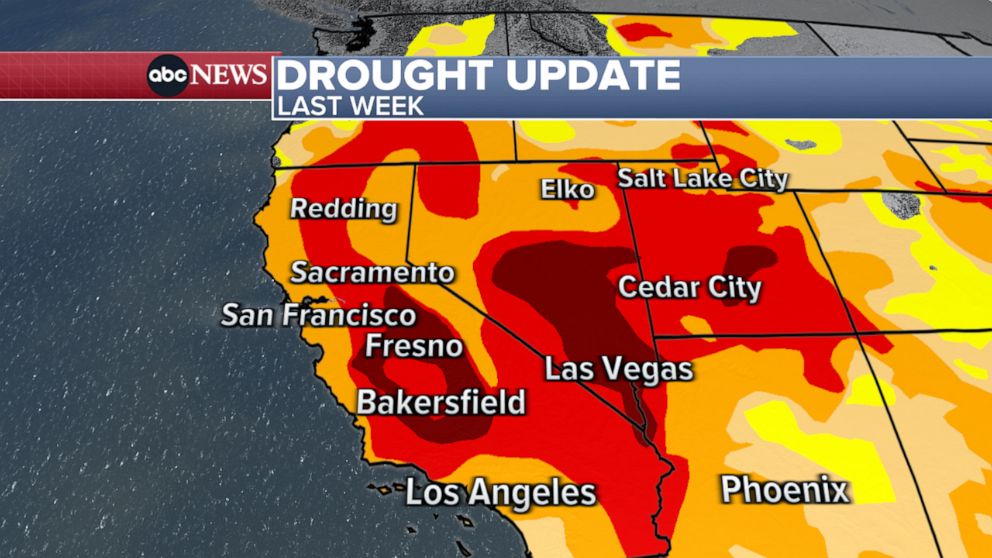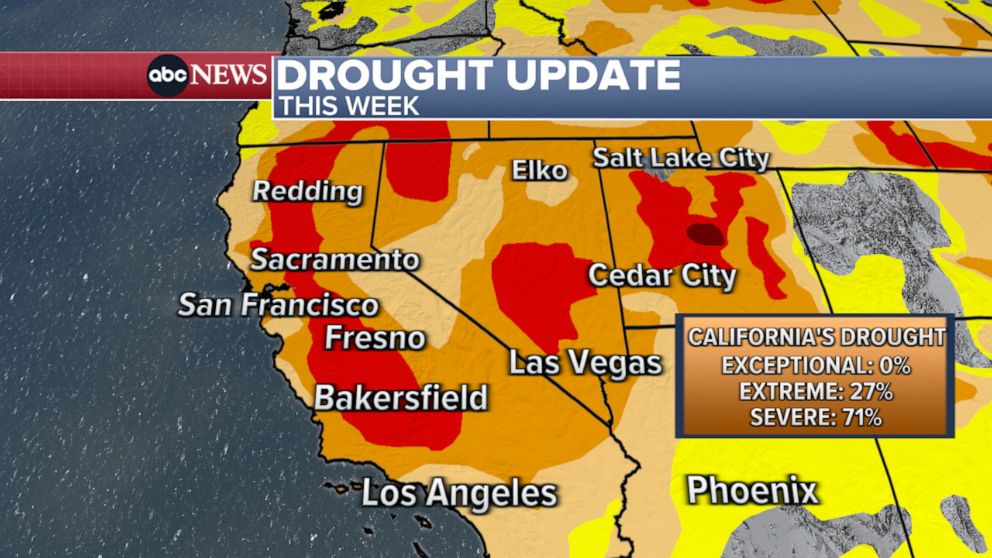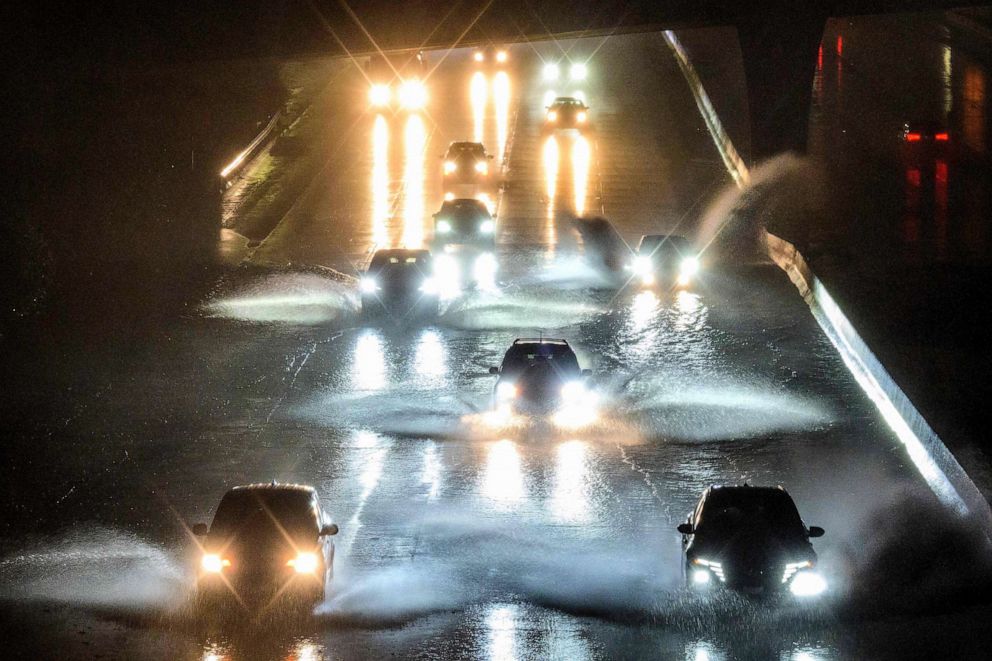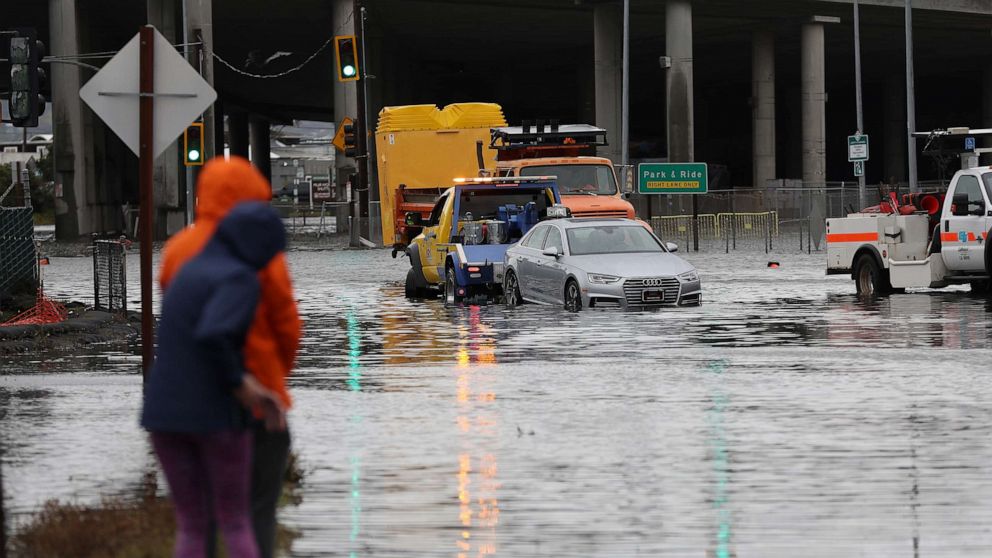The severe storms pummeling the drought-stricken West Coast has alleviated the drought status in two states, but the onslaught of moisture is unlikely to eradicate the decades-long extreme drought plaguing the region.
Portions of California and Nevada that were previously in "exceptional drought" status, no longer qualify for the highest level of concern due to the severe storms -- spurred by atmospheric rivers -- bringing an influx of rainfall to the region, according to data released by the U.S. Drought Monitor on Thursday.
California is currently at 0% exceptional drought, 27% extreme drought and 71% severe drought, while Nevada is currently at 0% exceptional drought, 24% extreme drought and 78% severe drought -- all due to the sudden inundation of rainfall in the past week, according to the Drought Monitor. The latest Drought Monitor data does not include the rainfall that occurred overnight Wednesday.
Last year, California was at nearly 1% exceptional drought, while Nevada was at nearly 8% exceptional drought, according to the Drought Monitor.


Some of the highest rainfall totals in the 24-hour period from Wednesday to Thursday morning came in at 5 inches in Potter Valley, north of the Bay Area, nearly 4 inches in Valley Christian, south of San Francisco and 4.67 inches in Los Angeles County. Major cities like San Francisco and Los Angeles experienced flooding as a result, and nearly 175,000 Pacific Gas and Electric Company customers were without power on Thursday morning.
About 90% of California residents were under a flash flood watch on Thursday, when waves of heavy rain were expected to continue. At least two people in Sonoma County were killed in storm-related accidents, officials said on Thursday.
A winter storm warning was in effect Thursday for the mountains outside of Los Angeles, where up to a foot of snow is possible.
The increase in moisture is so dramatic that San Francisco has gotten half of its annual rainfall totals -- 10 inches -- in the past 30 days.

Drivers barrel into standing water on Interstate 101 in San Francisco, Jan. 4, 2023.
Josh Edelson/AFP via Getty Images
But it will take several seasons at 120% to 200% the normal rain and snowfall to eliminate drought in the West, according to experts. A tough feat, considering the anthropogenic -- or human-induced -- warming many states in the West, including California and Nevada, are experiencing, Amir AghaKouchak, a professor at the University of San Diego who specializes in hydrological extremes and drought monitoring, told ABC News.
As climate change threatens to increase the frequency of extreme weather events and make them occur over shorter periods of time, the danger of swaying from hefty drought to inundating seasons becomes more likely, scientists predict.
Drought has "many dimensions," and climate change is expected to alter the relationship between drought and flooding in the West, AghaKouchak said.
"In a warmer climate, we expect more intense droughts, maybe longer drought, or more frequent droughts," he said. "But at the same time, we expect more extreme precipitation events."

People look on as a tow truck pulls a car out of a flooded intersection, Jan. 4, 2023, in Mill Valley, Calif.
Justin Sullivan/Getty Images
Switching from flood to drought and then from drought to flood conditions in a short amount of time is expected as well, AghaKouchak said. As large swaths of the Western U.S. experience explosive wildfires, the burn areas left in the wake are prime location for mudslides to occur. The parched earth cannot hold the sudden influx of water, which then mixes with sediments, creating potentially deadly situations.
While lack of rainfall is the biggest driver of drought, snowfall can make a big impact on water supplies as it melts in the spring. The current rainfall is doing little to refill the groundwater reserves, which are near depleted, AghaKouchak said.
In addition, the current storms along the West Coast will not help to ease water restrictions further east in communities that rely on Lake Mead and Lake Powell, the largest reservoirs in the country which are fed by the Colorado River.
ABC News' Max Golembo, Mel Griffin and Ginger Zee contributed to this report.
"severe" - Google News
January 06, 2023 at 06:48AM
https://ift.tt/7Vu4qZT
California, Nevada no longer under 'exceptional drought' conditions following severe influx of rainfall - ABC News
"severe" - Google News
https://ift.tt/QDa4Ex6
Shoes Man Tutorial
Pos News Update
Meme Update
Korean Entertainment News
Japan News Update
Bagikan Berita Ini















0 Response to "California, Nevada no longer under 'exceptional drought' conditions following severe influx of rainfall - ABC News"
Post a Comment